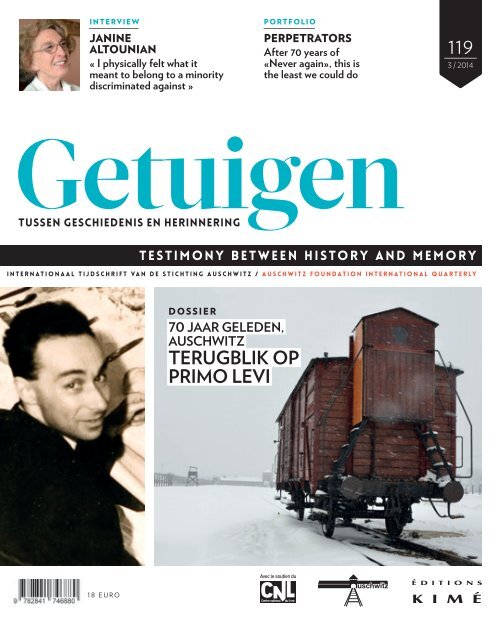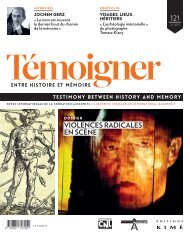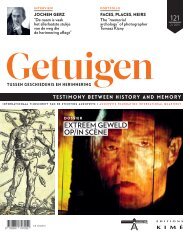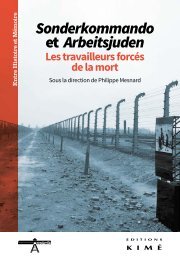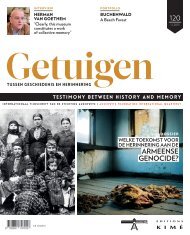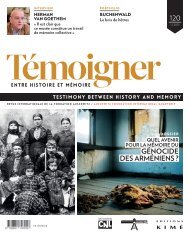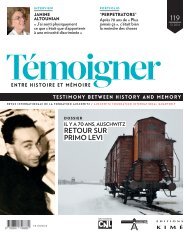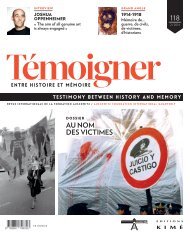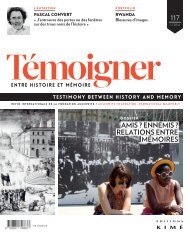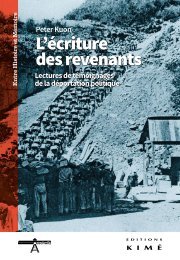Tijdschrift: Getuigen tussen geschiedenis en herinnering - Nr. 119 (december 2014): Dossier: 70 jaar geleden, Auschwitz. Terugblik op Primo Levi
27 januari 1945. Zeventig jaar geleden wandelden de eerste soldaten van het Rode Leger Auschwitz binnen. Men zou kunnen zeggen dat het kamp toen werd ‘bevrijd’, hoewel Auschwitz, en geen enkel ander nazikamp, ooit een prioriteit vormden voor de Geallieerden. Primo Levi was een van de weinige overlevenden die zich wisten te verbergen en zo ontsnapten aan de gedwongen evacuaties. Jood, gedeporteerde, chemicus, getuige, schrijver: we blikken terug op deze complexe figuur, op zijn evolutie tot wat hij zelf een ‘professionele overlevende’ noemde, op zijn oeuvre. En op de betekenis die hij aan de woorden ‘verzet’ en ‘engagement’ gaf.
27 januari 1945. Zeventig jaar geleden wandelden de eerste soldaten van het Rode Leger Auschwitz binnen. Men zou kunnen zeggen dat het kamp toen werd ‘bevrijd’, hoewel Auschwitz, en geen enkel ander nazikamp, ooit een prioriteit vormden voor de Geallieerden. Primo Levi was een van de weinige overlevenden die zich wisten te verbergen en zo ontsnapten aan de gedwongen evacuaties. Jood, gedeporteerde, chemicus, getuige, schrijver: we blikken terug op deze complexe figuur, op zijn evolutie tot wat hij zelf een ‘professionele overlevende’ noemde, op zijn oeuvre. En op de betekenis die hij aan de woorden ‘verzet’ en ‘engagement’ gaf.
- TAGS
- primo-levi
- auschwitz
You also want an ePaper? Increase the reach of your titles
YUMPU automatically turns print PDFs into web optimized ePapers that Google loves.
INTERVIEW<br />
JANINE<br />
ALTOUNIAN<br />
« I physically felt what it<br />
meant to belong to a minority<br />
discriminated against »<br />
PORTFOLIO<br />
PERPETRATORS<br />
After <strong>70</strong> years of<br />
«Never again», this is<br />
the least we could do<br />
<strong>119</strong><br />
3 / <strong>2014</strong><br />
<strong>tuss<strong>en</strong></strong> <strong>geschied<strong>en</strong>is</strong> <strong>en</strong> <strong>herinnering</strong><br />
Testimony betwe<strong>en</strong> history and memory<br />
Internationaal tijdschrift van de Stichting <strong>Auschwitz</strong> / auschwitz foundation international quarterly<br />
DOSSIER<br />
<strong>70</strong> JAAR GELEDEN,<br />
AUSCHWITZ<br />
TERUGBLIK OP<br />
PRIMO LEVI<br />
18 EURO
BEVRIJDING! BELGEN<br />
IN DUITSE KAMPEN<br />
Vanaf 2 april 2015 in<br />
Kazerne Dossin <strong>en</strong> het<br />
Fort van Bre<strong>en</strong>donk.<br />
LIBERATION! BELGIAN<br />
PRISONERS IN THE<br />
GERMAN CAMPS<br />
Op<strong>en</strong>ing on 2 April 2015<br />
in Kazerne Dossin and<br />
Fort Bre<strong>en</strong>donk.<br />
Kazerne Dossin<br />
Goswin de Stassartstraat 153<br />
B-2800 Mechel<strong>en</strong> – België<br />
Telefoon ma - vrij:<br />
+ 32 (0) 15 29 06 60<br />
(info <strong>en</strong> reservaties)<br />
Telefoon zat - zon:<br />
+ 32 (0) 15 28 86 40<br />
(noodnummer)<br />
Kazerne Dossin<br />
Goswin de Stassartstraat 153<br />
B-2800 Mechel<strong>en</strong> – Belgium<br />
Tel. number Mon-Fri:<br />
+ 32 (0) 15 29 06 60<br />
(info and reservations)<br />
Tel. number Sat-Sun:<br />
+ 32 (0) 15 28 86 40<br />
(only for emerg<strong>en</strong>cies)<br />
Het museum is <strong>op</strong><strong>en</strong>:<br />
Alle dag<strong>en</strong> van 10:00 tot 17:00.<br />
Geslot<strong>en</strong> <strong>op</strong> wo<strong>en</strong>sdag.<br />
Het museum is geslot<strong>en</strong>:<br />
Op wo<strong>en</strong>sdag, Kerstmis,<br />
Nieuw<strong>jaar</strong> <strong>en</strong> <strong>op</strong> Joodse<br />
feestdag<strong>en</strong> (Rosh Hasjana<br />
<strong>en</strong> Jom Kipoer).<br />
The Museum is <strong>op</strong><strong>en</strong>:<br />
All week from 10 AM - 5 PM<br />
except on Wednesdays.<br />
The Museum is closed:<br />
On Wednesdays, on Christmas<br />
and New Year’s Day,<br />
and on Jewish holidays<br />
(Rosh Hashana, Yom Kippur).<br />
www.kazernedossin.eu<br />
Inhoudstafel<br />
NR. <strong>119</strong> – DECEMBER <strong>2014</strong><br />
4 REDACTIONEEL<br />
7 AGENDA<br />
10 KRONIEK<br />
10 Daniel Hernández-Salazar:<br />
Revealing the image, revealing truth<br />
18 G<strong>en</strong>eration War<br />
22 Filmoverzicht<br />
26 <strong>Getuig<strong>en</strong></strong>, NU : Passages<br />
van Catherine Dajczman<br />
28 Anne Frank, het succes van e<strong>en</strong> symbool<br />
32 New ghost stories.<br />
Images as memorial survival<br />
34 E<strong>en</strong> onvoltooide <strong>op</strong>era<br />
35 Babi Yar, e<strong>en</strong> bijzondere getuig<strong>en</strong>is<br />
door Kondrasjin<br />
37 Korngold’s Kathrin by Forbidd<strong>en</strong> Music<br />
41 PORTFOLIO<br />
PERPETRATORS<br />
50 INTERVIEW<br />
Janine Altounian<br />
“I PHYSICALLY FELT WHAT IT<br />
MEANT TO BELONG TO A MINORITY<br />
DISCRIMINATED AGAINST”<br />
60 DOSSIER<br />
144 VARIA<br />
144 Is time out of joint Rise and fall of<br />
the time regime of Modernity<br />
Clotilde Coueille<br />
150 T<strong>op</strong>oï<br />
Aurélie Barjonet<br />
155 Rwanda 1994-<strong>2014</strong> :<br />
G<strong>en</strong>ocide <strong>en</strong>/in fictie<br />
François-Xavier Destors<br />
60<br />
62 Inleiding<br />
DOSSIER<br />
66 <strong>Primo</strong> <strong>Levi</strong> <strong>en</strong> het Verzet<br />
Frediano Sessi<br />
78 Betwe<strong>en</strong> testimony and memory,<br />
what place for <strong>Primo</strong> <strong>Levi</strong><br />
Philippe Mesnard<br />
93 The Periodic Table:<br />
<strong>en</strong>cryptions and decipherings<br />
Luba Jurg<strong>en</strong>son<br />
112 <strong>Levi</strong>, Calvino <strong>en</strong> de grijze zone<br />
Carlo Ginzburg<br />
<strong>119</strong> Mijn twee ontmoeting<strong>en</strong> met <strong>Primo</strong> <strong>Levi</strong><br />
Daniela Amsallem<br />
128 Terug naar <strong>Auschwitz</strong><br />
<strong>Primo</strong> <strong>Levi</strong><br />
137 Biografie<br />
<strong>70</strong> JAAR GELEDEN, AUSCHWITZ<br />
TERUGBLIK<br />
OP PRIMO LEVI<br />
140 Bibliografie<br />
172 WOORDENBOEK OVER GETUIGENIS<br />
EN HERINNERING<br />
l Archeology of the Holocaut l The Frontoviki<br />
l Geoffrey Hartman l Memory and the<br />
anthr<strong>op</strong>oc<strong>en</strong>e l Multidirectional memory<br />
l September 11, 2001 l Transcultural memory<br />
l Memorial site: Diksmuide<br />
184 HERINNERINGSLABO<br />
192 BOEKENPLANK<br />
206 NIET TE MISSEN<br />
Testimony Betwe<strong>en</strong> History and Memory – n°<strong>119</strong> / December <strong>2014</strong> 3
WHAT IS OURS<br />
TO CONTEND<br />
WITH A Philippe Mesnard,<br />
hoofd van de redactie<br />
We are <strong>en</strong>tering the commemorative<br />
cal<strong>en</strong>dar celebrating the <strong>70</strong> years of the <strong>en</strong>d of the<br />
Second World War and the so-called “liberation” of<br />
<strong>Auschwitz</strong>. I have always be<strong>en</strong> struck by the ease with<br />
which inadequate or ill-chos<strong>en</strong> terms are employed<br />
regarding such serious questions, passing as elem<strong>en</strong>tary<br />
truths. Indeed, ev<strong>en</strong> if Soviet soldiers repres<strong>en</strong>ted<br />
liberators in the eyes of the deportees, we know that<br />
the camp had be<strong>en</strong> abandoned by the SS before they<br />
arrived. I do not wish to once again pick up the refrain<br />
that the camps were never a strategic objective, but<br />
rather to examine how such words are employed, which<br />
are evid<strong>en</strong>tly used without any critical distance. Wh<strong>en</strong><br />
one word is excessively repeated from mouth to mouth,<br />
this should serve as a warning to immediately shift our<br />
att<strong>en</strong>tion from its refer<strong>en</strong>tial value to that which its<br />
repetitive nature may <strong>op</strong>acify. Yet, it is g<strong>en</strong>erally the<br />
contrary. The more we hear the word, the more we<br />
repeat it until it constructs an <strong>en</strong>tire doxa. This is the<br />
case for the expression the “disappearing of the witnesses”.<br />
Let’s take a closer look.<br />
The expression owes its semantic power to the<br />
theo logical theme of the last witnesses, but not only.<br />
FIFTEEN YEARS AGO, THERE WAS ALREADY<br />
TALK OF THE DISAPPEARING OF THE WIT-<br />
NESSES, and I thought that it was quite unfortunate<br />
to inform these pe<strong>op</strong>le about what they already knew,<br />
what everyone knows: the finit<strong>en</strong>ess of life. And if, for<br />
Redactioneel<br />
some, life is prolonged by “the d<strong>en</strong>se grass of fecund<br />
works” (Proust), this continuation does not bear any<br />
incid<strong>en</strong>ce on the biological l<strong>en</strong>gth of our ordinary exist<strong>en</strong>ces.<br />
WHY SHOULD ONE PERSIST, AT THE RISK<br />
OF HURTING THEM, in harping on about this observation,<br />
a fortiori, to individuals who lived an experi<strong>en</strong>ce<br />
loaded with viol<strong>en</strong>ce and death, and who have come to<br />
repres<strong>en</strong>t it to the eyes of the world There is admittedly<br />
fear behind all of this, but not only. Such fear<br />
did not arise with other ev<strong>en</strong>ts, 1914-1918 soldiers for<br />
example, nor was it turned into such a commonplace<br />
and ad<strong>op</strong>ted unanimously.<br />
The great recording campaigns of the 1990s and<br />
years 2000 tried however to anticipate the abs<strong>en</strong>ce.<br />
Initiated by the Fortunoff project at Yale, th<strong>en</strong> spread<br />
worldwide by the Spielberg Foundation, the recordings<br />
<strong>en</strong>abled collecting multiple stories of the experi<strong>en</strong>ce of<br />
Nazi terror by the pe<strong>op</strong>le who today are leaving us, as<br />
we are told. But the accumulation of t<strong>en</strong>s of thousands<br />
of hours, curr<strong>en</strong>tly being filed away, and the promise of<br />
a digital eternity as it were, do not solve the question<br />
of the disappearing of the witnesses.<br />
It does not temper the obsessive resurg<strong>en</strong>ce of this<br />
commonplace. I tell myself that the expression may<br />
point to the disarray of not having found a per<strong>en</strong>nial<br />
model for the transmission of a collective experi<strong>en</strong>ce,<br />
the radicalism and diversity of the viol<strong>en</strong>ce having<br />
lastingly exceeded the measures admitted by the time<br />
wh<strong>en</strong> they were perpetrated, and still today exceed<br />
our curr<strong>en</strong>t time. Contiguous to the “disappearing of<br />
the witnesses,” THIS DISARRAY IS MOST LIKELY<br />
COMPENSATED BY THE PEDAGOGICAL ENTHU-<br />
SIASM TO REACH OUT TO YOUNG AUDIENCES,<br />
in secondary school, sometimes ev<strong>en</strong> in elem<strong>en</strong>tary<br />
school, in order to teach this historical period. But<br />
again, as much as these initiatives are certainly necessary,<br />
we also have the impression that the boat continues<br />
to take water. Anti-Semitism, indeed, is not<br />
decreasing. It now pushes forward yet masked in differ<strong>en</strong>t<br />
methods, and extremist parties have recorded<br />
a surprising progression in Eur<strong>op</strong>e, from its heart<br />
(Hungary) all the way to its Western and Eastern edges.<br />
I recall that in his final book, The Drowned and the<br />
Saved (1985), and more precisely in the chapter about<br />
the “grey zone”, <strong>Primo</strong> <strong>Levi</strong> questioned the testimonial<br />
models of transmission. He reproached as much the<br />
deportees – himself in the first place –, as the youth<br />
for having mutually settled on stereotyped versions,<br />
thus not only limiting the understanding of the ev<strong>en</strong>ts,<br />
but also losing their relevance in today’s world, merely<br />
becoming “history”. After having sp<strong>en</strong>t tw<strong>en</strong>ty years<br />
testifying in schools, he acknowledged not the disappearing<br />
of the witnesses (on 11 April 1987 he who would<br />
throw himself from the third floor to the bottom of the<br />
Errata<br />
Editorial<br />
stairs in his apartm<strong>en</strong>t block), but the failure of transmission.<br />
This is where the real problem of our time lays.<br />
It is not necessarily about finding the answers, but finding<br />
the right questions which concern us – those “great<br />
ethical questions” that Imre Kertész referred to.<br />
In his confer<strong>en</strong>ce “The Holocaust as culture” (1992),<br />
Imre Kertész prolonged in his own way <strong>Primo</strong> <strong>Levi</strong>’s<br />
reflection. IT IS NOT WITH “CONDOLENCES”, HE<br />
SAYS, NOR WITH “REGRET” THAT THE GENO-<br />
CIDE OF THE JEWS SHALL ACQUIRE A PLACE<br />
WITHIN CULTURE all the while escaping a fetichization,<br />
sacralization and reduction from an explicative<br />
discourse. For such a place to become an “indisp<strong>en</strong>sable”<br />
part of our consciousness, he goes on, it must<br />
be founded on a “value judgem<strong>en</strong>t” which cannot be<br />
restricted to a lesson of morality. Kertész, whose ideas<br />
have become universal since 1989, would surely agree<br />
that we carry on his work by stating that any investigation<br />
into the foundations of our “ideal” world, which we<br />
so resolutely want to establish on human rights, should<br />
reckon with <strong>Auschwitz</strong> and critically review the models<br />
that we have become too comfortably accustomed<br />
to. While the witnesses are truly disappearing, this is<br />
where lies the problem which is ours to cont<strong>en</strong>d with,<br />
<strong>70</strong> years after the “liberation” of <strong>Auschwitz</strong>. ❚<br />
Translation: Sarah Voke<br />
In nummer 118 versche<strong>en</strong> het artikel ‘It happ<strong>en</strong>ed sev<strong>en</strong>ty years ago, in Hungary’ van Szabolcs Szita (136-144). Het werd vertaald uit het<br />
Hongaars door Robert Istvan Bodi <strong>en</strong> gereviseerd door Janos Frühling <strong>en</strong> Annele<strong>en</strong> Spiess<strong>en</strong>s. – Het dossier ‘In naam van de slachtoffers’<br />
(74-135) <strong>en</strong> de Nederlandstalige tekst<strong>en</strong> uit de Kroniek werd<strong>en</strong> uit het Frans vertaald door Annele<strong>en</strong> Spiess<strong>en</strong>s.<br />
4 <strong>Getuig<strong>en</strong></strong> <strong>tuss<strong>en</strong></strong> <strong>geschied<strong>en</strong>is</strong> <strong>en</strong> <strong>herinnering</strong> – nr. <strong>119</strong> / <strong>december</strong> <strong>2014</strong> Testimony Betwe<strong>en</strong> History and Memory – n°<strong>119</strong> / December <strong>2014</strong><br />
5
Chroniques<br />
Logbook<br />
REVEALING THE IMAGE,<br />
REVEALING TRUTH<br />
Daniel Hernández-Salazar’s visual memory<br />
of the g<strong>en</strong>ocide in Guatemala<br />
EXHIBITION From the modernity of the<br />
Angels. After Klee’s painting, which is now<br />
better known through Walter B<strong>en</strong>jamin’s<br />
comm<strong>en</strong>tary than by itself, and after Wim<br />
W<strong>en</strong>der’s Wings of desire, we now have<br />
to make way for this Angel which comes<br />
from Guatemala to point out the viol<strong>en</strong>ce<br />
<strong>en</strong>dured by the Maya pe<strong>op</strong>le.<br />
AInterview by Annele<strong>en</strong> Spiess<strong>en</strong>s & Janiv Stamberger<br />
During Guatemala’s 36-year Civil War (1960-<br />
1996), the military governm<strong>en</strong>t <strong>en</strong>gaged<br />
in a brutal “counterinsurg<strong>en</strong>cy” campaign<br />
against all forms of <strong>op</strong>position. The rural<br />
Mayan p<strong>op</strong>ulation especially was singled out as the<br />
governm<strong>en</strong>t accused them of siding with revolutionary<br />
armed groups. In the 1980s, the army and its paramilitary<br />
groups applied a “scorched earth” policy, resulting<br />
not only in the systematic assassination and relocation<br />
of indig<strong>en</strong>ous communities, but also in the destruction<br />
of <strong>en</strong>tire villages and sacred places. Guatemala’s<br />
Truth Commission (Comisión para el Esclarecimi<strong>en</strong>to<br />
Histórico) reported in 1999 that 83% of the 200,000<br />
victims of the war were Mayan and concluded that the<br />
State viol<strong>en</strong>ce against the Ixil Maya pe<strong>op</strong>le amounted<br />
to “acts of g<strong>en</strong>ocide”. A peace accord was signed in<br />
1996, but this has not resulted in the construction of<br />
a collective and inclusive memory of the g<strong>en</strong>ocide in<br />
Guatemala, nor has it succeeded in providing justice for<br />
the victims. In May 2013 human rights organizations<br />
hailed the “historical” conviction of Efraín Ríos Montt,<br />
Chief of State at the height of the military campaign<br />
(1982-1983), for g<strong>en</strong>ocide and crimes against humanity.<br />
A few days later, however, the s<strong>en</strong>t<strong>en</strong>ce was revoked<br />
by the Constitutional Court on procedural grounds.<br />
© Annele<strong>en</strong> Spiess<strong>en</strong>s<br />
With his pictures of the exhumations and protests,<br />
photographer and human rights activist Daniel<br />
Hernández-Salazar brings the plight of the survivors<br />
and the victims’ families into the public eye, <strong>en</strong>dorsing<br />
their call for recognition and social justice. His picture<br />
depicting a mestizo angel with wings made from the<br />
scapulae bones of one of the nameless victims of the<br />
g<strong>en</strong>ocide has become an iconic image in Guatemala.<br />
The artist’s work is curr<strong>en</strong>tly on display at Kazerne<br />
Dossin.<br />
Daniel Hernández-Salazar, can you tell us about your<br />
professional background and how you came to be a photographer<br />
Daniel Hernández-Salazar: Taking photographs has<br />
always be<strong>en</strong> a passion for me. I started taking pictures<br />
from a very young age. Nevertheless, I decided to study<br />
BIOGRAPHY<br />
i<br />
1956 / born<br />
1974 / starts studying Architecture<br />
1978 / starts his career in Fine Art<br />
Photography<br />
1980s / works for several international news<br />
ag<strong>en</strong>cies (Reuters, AFP, Associated Press)<br />
and starts docum<strong>en</strong>ting the Civil War in<br />
Guatemala<br />
1993 / receives a replica of the Nobel Peace<br />
Prize Medal from Rigoberta M<strong>en</strong>chú Tum<br />
1998 / his polyptych Esclarecimi<strong>en</strong>to/<br />
Clarification appears on the cover of<br />
Guatemala: Never Again, the final report of<br />
Bish<strong>op</strong> Juan José Gerardi’s “Recovery of<br />
Historical Memory” project (REMHI)<br />
1998 / is awarded the Jonathan Mann<br />
Humanitas Award for his artistic work on<br />
human rights issues<br />
2004 / publishes his first anthology,<br />
Guatamala, Memoria de un Ángel (Kage<br />
Shobo)<br />
2005 / is decorated and made Knight of the<br />
Order of Arts and Letters by the Ministry of<br />
Culture and Communications of France<br />
2007 / publishes Para que todos lo sepan/<br />
So That All Shall Know (University of Texas<br />
Press)<br />
<strong>2014</strong> / pres<strong>en</strong>ts two exhibitions in Belgium.<br />
architecture, which actually influ<strong>en</strong>ced the way I think<br />
and perceive things – and the way I make photographs.<br />
There I learned about composition, light and colour.<br />
Wh<strong>en</strong> a major earthquake shook Guatemala in 1976,<br />
I began working on the reconstruction of the cathedral<br />
of Guatemala City. I was hired as a draftsman to<br />
outline the reconstruction process but also began to<br />
take pictures of the project. That was the beginning of<br />
my career as a professional photographer. I continued<br />
studying architecture for several years while working<br />
as a photographer but ev<strong>en</strong>tually decided not to<br />
continue my studies and to focus on my photography<br />
instead.<br />
At what point in time did you make the transition from<br />
being an architectural photographer to a chronicler of<br />
Mayan culture and especially of the darker chapters of<br />
Guatemalan history, namely the g<strong>en</strong>ocide and its effect<br />
on Guatemalan society<br />
Daniel Hernández-Salazar: I have always be<strong>en</strong> very s<strong>en</strong>sitive<br />
and aware of the power of communication and<br />
of the role and influ<strong>en</strong>ce media have on society. That<br />
became more clear wh<strong>en</strong> I started working as a photojournalist<br />
for newspapers in Guatemala, and later as<br />
a correspond<strong>en</strong>t for press ag<strong>en</strong>cies. The period wh<strong>en</strong><br />
I worked for Associated Press coincided with the last<br />
years of the war. Being a journalist at that time helped<br />
me to decide which direction I wanted to take with<br />
my work. I have always be<strong>en</strong> attuned to social issues,<br />
but working with the press helped me focus the way<br />
I wanted to commit myself – and understand how to<br />
use photography as an instrum<strong>en</strong>t, as a tool to convey<br />
a certain message to make pe<strong>op</strong>le aware of important<br />
ev<strong>en</strong>ts taking place. I understood the importance of<br />
leaving traces, graphic docum<strong>en</strong>ts of what happ<strong>en</strong>ed.<br />
The exhibition in Kazerne Dossin seems to be very<br />
differ<strong>en</strong>t from the one in Galerie Verbeeck-Van Dyck in<br />
Antwerp wh<strong>en</strong> it comes to “docum<strong>en</strong>ting” the g<strong>en</strong>ocide.<br />
Daniel Hernández-Salazar: Indeed, the exhibition in<br />
Kazerne Dossin focuses more on the photojournalistic<br />
docum<strong>en</strong>tary work I have done and continue to<br />
do. It reveals my interest in preserving what I would<br />
call a “visual memory” of the g<strong>en</strong>ocide. The exhibition<br />
in Antwerp shows another side of my work. I used a<br />
differ<strong>en</strong>t method to create the pieces I pres<strong>en</strong>ted at<br />
Galerie Verbeeck-Van Dyck to convey emotions and<br />
make them more personal. I cut the photos in pieces<br />
and afterwards reconstruct them with nails or scotch<br />
tape to repres<strong>en</strong>t rupture and pain. Another layer is<br />
added to the truth-value of the pictures, a more metaphorical<br />
and subjective one that refers to universal<br />
human themes like life, death or love, and transmits my<br />
artistic int<strong>en</strong>tion. During my career as a photographer,<br />
I have tried to combine both the need of communicating<br />
a message to the outside world and the need of<br />
expressing myself through my work. That is still true<br />
today, but I am more conscious of it now. I believe both<br />
approaches work, for me and for the public.<br />
How do you conceive of the role of art – of your art – in<br />
society Should all art “work”<br />
Daniel Hernández-Salazar: Well, I believe art has a specific<br />
function in society. Some pe<strong>op</strong>le think art is just for<br />
fun or to decorate a house: “the painting or photograph<br />
should match the rug or the curtains”. I do not agree<br />
l l l<br />
10 <strong>Getuig<strong>en</strong></strong> <strong>tuss<strong>en</strong></strong> <strong>geschied<strong>en</strong>is</strong> <strong>en</strong> <strong>herinnering</strong> – nr. <strong>119</strong> / <strong>december</strong> <strong>2014</strong> Testimony Betwe<strong>en</strong> History and Memory – n°<strong>119</strong> / December <strong>2014</strong><br />
11
Portfolio<br />
© Ph. M.<br />
PERPETRATORS<br />
Perpetrators. Etymology: < post-classical Latin perpetrator person who<br />
perpetrates something, especially a crime or evil deed (4th c<strong>en</strong>t.) < classical<br />
Latin perpetrat-, past participial stem of perpetrare + -or. Compare Middle<br />
Fr<strong>en</strong>ch perpetrateur (c1450).<br />
0 Court room where the trial of Adolf<br />
Eichmann took place in 1961. Originally, it<br />
was Jerusalem’s Beit Ha’am (Pe<strong>op</strong>le’s House)<br />
theatre.<br />
© All rights reserved<br />
© Ph. M.<br />
. Poznan, Poland.<br />
Billboard for Dani<br />
Levy’s burlesque film<br />
Mon Führer: La Vraie<br />
Véritable Histoire d’Adolf<br />
Hitler (My Führer: The<br />
Real Auth<strong>en</strong>tic Story of<br />
Adolf Hitler, 2007).<br />
Could it be that victims are overly exposed<br />
in our society That they are too pres<strong>en</strong>t<br />
Endorsing their struggle for recognition, their<br />
demands and their h<strong>op</strong>es, should we be wary<br />
of the danger of saturating our collective memory Of<br />
submerging or tainting it Perhaps victims in g<strong>en</strong>eral<br />
occupy a promin<strong>en</strong>t position – an all too promin<strong>en</strong>t<br />
one, according to some – in today’s discourse on and<br />
repres<strong>en</strong>tations of viol<strong>en</strong>ce. Maybe so. But th<strong>en</strong> again,<br />
what are we to make of the visibility of notorious criminals<br />
in our culture They are no less visible than the<br />
victims, but strangely <strong>en</strong>ough, they are not targeted<br />
by the critics. Their visibility is “natural” to us, so it<br />
seems. Their portraits, their smiles, their replications,<br />
their pres<strong>en</strong>ce, their t<strong>op</strong>icality, have be<strong>en</strong> stirring our<br />
imagination for c<strong>en</strong>turies, to the ext<strong>en</strong>t that we have<br />
now become accustomed to a certain level of darkness.<br />
For writers, they are a source of inspiration, leading to<br />
the publication of a brilliant best-seller every now and<br />
th<strong>en</strong>. Criminals also p<strong>op</strong>ulate the blockbusters of our<br />
time. In sum, our culture and everyday-life is permeated<br />
by the figure of the perpetrator.<br />
Some readers might feel uncomfortable with our<br />
decision to juxtapose their images, creating some kind<br />
of family photo album, as it were. Especially because<br />
the album shows them in differ<strong>en</strong>t situations and<br />
postures, making them look more or less flattering or<br />
arrogant. Moreover, what is left from them is oft<strong>en</strong> not<br />
ev<strong>en</strong> their portrait but their attributes – SS, swastika,<br />
moustache –, which goes to show just how omnipres<strong>en</strong>t<br />
Nazi refer<strong>en</strong>ces are in our society. It is through their<br />
attributes that these infamous m<strong>en</strong> continue to metonymically<br />
impose their pres<strong>en</strong>ce and keep circulating,<br />
from one poster to another. After <strong>70</strong> years of “Never<br />
again”, the least we can do is to devote a portfolio to<br />
them. ❚<br />
Philippe Mesnard<br />
(Translation: Annele<strong>en</strong> Spiess<strong>en</strong>s)<br />
. Poznan, Poland.<br />
Parliam<strong>en</strong>tary elections<br />
of 2007. Graffiti on the<br />
candidates of the Civic<br />
Platform (the party<br />
is still in power today<br />
and holds a majority in<br />
Parliam<strong>en</strong>t).<br />
41 <strong>Getuig<strong>en</strong></strong> <strong>tuss<strong>en</strong></strong> <strong>geschied<strong>en</strong>is</strong> <strong>en</strong> <strong>herinnering</strong> – nr. <strong>119</strong> / <strong>december</strong> <strong>2014</strong> Testimony Betwe<strong>en</strong> History and Memory – n°<strong>119</strong> / December <strong>2014</strong><br />
44
Interview<br />
Interview<br />
If we shall commemorate the <strong>op</strong><strong>en</strong>ing of the <strong>Auschwitz</strong> camp in January 2015, next<br />
April we shall look to the c<strong>en</strong>t<strong>en</strong>ary not of a liberation but of the first g<strong>en</strong>ocide<br />
of the c<strong>en</strong>tury which struck Turkey’s Arm<strong>en</strong>ian community in 1915. Testimony will<br />
dedicate its next dossier not to the facts, but to the construction of its memory and its<br />
internationally curr<strong>en</strong>t nature. This will be included in the issue n°120, released in April<br />
2015. However, we wished to meet with Janine Altounian well beforehand.<br />
AInterview by Luba Jurg<strong>en</strong>son and Philippe Mesnard / Translation: Sarah Voke<br />
Janine Altounian<br />
❝<br />
I PHYSICALLY FELT WHAT<br />
IT MEANT TO BELONG<br />
TO A MINORITY<br />
DISCRIMINATED AGAINST❞<br />
Janine Altounian is one of the great figures<br />
of the Fr<strong>en</strong>ch speaking intellectual<br />
milieu who, since several decades<br />
already, bears a consciousness of the<br />
Arm<strong>en</strong>ian g<strong>en</strong>ocide. She takes part in<br />
all major ev<strong>en</strong>ts, she has published numerous works on<br />
the g<strong>en</strong>ocide and manifold articles on Freud’s language,<br />
of whom she is one of the translators, as well as on<br />
traumatic transmission. Especially, she has remained<br />
accessible, extremely modest in the face of the ext<strong>en</strong>t<br />
of the task she has set for herself, whereas all too oft<strong>en</strong><br />
– sometimes by def<strong>en</strong>se, at times simply giving in to<br />
one’s s<strong>en</strong>se of own self-glory – we see memorial actors<br />
become self-inflated. We w<strong>en</strong>t to interview her with<br />
Anouche Kunthe who, as an historian, studies exile and,<br />
more precisely, the Arm<strong>en</strong>ian Diaspora.<br />
Janine Altounian never knew her par<strong>en</strong>ts’ or her<br />
ancestors’ land, since her mother and father, before meeting<br />
each other in France, had escaped the g<strong>en</strong>ocide perpetrated<br />
in Turkey upon Arm<strong>en</strong>ian p<strong>op</strong>ulations. Altounian<br />
visited this land twice, in 2013 and in <strong>2014</strong>. Up until th<strong>en</strong>,<br />
she had only known it through imagination, in other words<br />
through the few narratives her maternal grandmother had<br />
told her and the terror emanating from past ev<strong>en</strong>ts which<br />
did not have any precise legal qualification (it was in 1944<br />
that Raphael Lemkin created the term of g<strong>en</strong>ocide). Did<br />
this project mature over a long period<br />
Janine Altounian: The desire to see one’s par<strong>en</strong>ts’ land<br />
obviously arises at a certain point in life for Arm<strong>en</strong>ians<br />
of the Diaspora. For a long time I had int<strong>en</strong>ded to go<br />
to Turkey, yet I did not want to go as a tourist, I was<br />
waiting, in a way, for an institutional circumstance.<br />
Furthermore, I first had to deal with the heritage of<br />
material goods left by my par<strong>en</strong>ts. It is, in fact, wh<strong>en</strong><br />
survivors die that the desc<strong>en</strong>dants’ memory takes a<br />
new turn. It is only wh<strong>en</strong> they disappear that, at that<br />
mom<strong>en</strong>t, they are totally tak<strong>en</strong> care of. My last living<br />
par<strong>en</strong>t, my mother, died in 2005 and you know how<br />
things are in such circumstances: there is the house<br />
to empty, the grieving process, etc. All of this took me<br />
at least five years. In addition to loosing my par<strong>en</strong>ts<br />
and the world they repres<strong>en</strong>ted, my translation of the<br />
Œuvres complètes de Freud (Freud’s Complete<br />
l l l<br />
© Ph. M.<br />
50 <strong>Getuig<strong>en</strong></strong> <strong>tuss<strong>en</strong></strong> <strong>geschied<strong>en</strong>is</strong> <strong>en</strong> <strong>herinnering</strong> – nr. <strong>119</strong> / <strong>december</strong> <strong>2014</strong> Testimony Betwe<strong>en</strong> History and Memory – n°<strong>119</strong> / December <strong>2014</strong><br />
51
DOSSIER<br />
A Onder leiding van<br />
Philippe Mesnard<br />
<strong>70</strong> JAAR GELEDEN, AUSCHWITZ<br />
TERUGBLIK OP<br />
PRIMO LEVI<br />
<strong>Primo</strong> <strong>Levi</strong> is van de meest toonaangev<strong>en</strong>de getuig<strong>en</strong> over de<br />
conc<strong>en</strong>tratiekamp<strong>en</strong>. Zijn grote verdi<strong>en</strong>ste bestaat erin dat hij de<br />
<strong>geschied<strong>en</strong>is</strong> van de kamp<strong>en</strong> e<strong>en</strong> universele draagwijdte heeft gegev<strong>en</strong>. Toch<br />
zoud<strong>en</strong> we afbreuk do<strong>en</strong> aan de <strong>op</strong>merkelijke rol die <strong>Levi</strong> heeft gespeeld,<br />
door hem louter als e<strong>en</strong> getuige, zij het e<strong>en</strong> promin<strong>en</strong>te, te beschouw<strong>en</strong>.<br />
Andere aspect<strong>en</strong> van zijn persoon <strong>en</strong> zijn werk blijv<strong>en</strong> <strong>op</strong> die manier<br />
onderbelicht: <strong>Primo</strong> <strong>Levi</strong> was immers e<strong>en</strong> echte intellectueel die zich m<strong>en</strong>gde<br />
in de politieke <strong>en</strong> literaire debatt<strong>en</strong> van zijn tijd. Met zijn gedicht<strong>en</strong>, romans,<br />
novelles, toneelstukk<strong>en</strong> <strong>en</strong> essays laat hij e<strong>en</strong> oeuvre na dat de categorie van<br />
getuig<strong>en</strong>is ver overstijgt.<br />
© Alle recht<strong>en</strong> voorbehoud<strong>en</strong><br />
Testimony Betwe<strong>en</strong> History and Memory – n°<strong>119</strong> / December <strong>2014</strong> 61
DOSSIER<br />
<strong>70</strong> JAAR GELEDEN, AUSCHWITZ. TERUGBLIK OP PRIMO LEVI<br />
INLEIDING<br />
<strong>70</strong> <strong>jaar</strong> geled<strong>en</strong>, in<br />
januari 1945, wist <strong>Primo</strong> <strong>Levi</strong> nog van<br />
niets. Hij wist niet dat hij e<strong>en</strong> van de<br />
meest toonaangev<strong>en</strong>de getuig<strong>en</strong> zou<br />
word<strong>en</strong> van de gruwel in de naziconc<strong>en</strong>tratiekamp<strong>en</strong>.<br />
Zelfs to<strong>en</strong> hij vrij kwam,<br />
wist hij niet dat hij het zou hal<strong>en</strong>: vele<br />
m<strong>en</strong>s<strong>en</strong> die de terreur van de SS hadd<strong>en</strong><br />
overleefd, bezwek<strong>en</strong> uiteindelijk aan<br />
ziekte, ondervoeding of aan de winterkoude.<br />
Weer thuis wachtte hem de ervaring,<br />
of ervaring<strong>en</strong>, van het schrijv<strong>en</strong>. <strong>Levi</strong>’s<br />
antwoord <strong>op</strong> de ervaring van deportatie,<br />
uitroeiing <strong>en</strong> gevang<strong>en</strong>schap bestond<br />
uit poëzie, roman, theater <strong>en</strong> essay.<br />
Zijn tekst<strong>en</strong> drag<strong>en</strong> al die ervaring<strong>en</strong><br />
in zich, bewar<strong>en</strong> <strong>en</strong> bewak<strong>en</strong> ze, gev<strong>en</strong><br />
ze e<strong>en</strong> betek<strong>en</strong>is in e<strong>en</strong> oeuvre dat veel<br />
meer is dan e<strong>en</strong> getuig<strong>en</strong>is alle<strong>en</strong>. Tuss<strong>en</strong><br />
1946 <strong>en</strong> de jar<strong>en</strong> zestig eist<strong>en</strong> zijn<br />
gezin, zijn carrière <strong>en</strong> de liefde hun<br />
plaats <strong>op</strong>. Het was e<strong>en</strong> terugkeer naar<br />
het lev<strong>en</strong> dat niettemin verstoord werd<br />
door geest<strong>en</strong> uit het verled<strong>en</strong>, nachtmerries<br />
<strong>en</strong> schuldgevoel<strong>en</strong>s. Via e<strong>en</strong><br />
sam<strong>en</strong>lo<strong>op</strong> van omstandighed<strong>en</strong>, dankzij<br />
persoonlijke contact<strong>en</strong> <strong>en</strong> e<strong>en</strong> reeks<br />
herd<strong>en</strong>king<strong>en</strong>, was <strong>Primo</strong> <strong>Levi</strong> uiteindelijk<br />
bestemd om te getuig<strong>en</strong>. <strong>Getuig<strong>en</strong></strong><br />
is zijn bestemming geword<strong>en</strong> – met alle<br />
garanties die dat woord biedt maar ook<br />
met de last, de druk <strong>en</strong> de vermoei<strong>en</strong>is<br />
die het met zich meebr<strong>en</strong>gt. Hoe vaker<br />
hij getuig<strong>en</strong>is aflegde, <strong>op</strong> de manier<br />
waar<strong>op</strong> m<strong>en</strong>s<strong>en</strong> dat van hem verwachtt<strong>en</strong>,<br />
<strong>en</strong> hoe meer hij de juiste toon vond<br />
© Alle recht<strong>en</strong> voorbehoud<strong>en</strong>, Coll. Ian Thomson<br />
om zijn verhaal te br<strong>en</strong>g<strong>en</strong>, hoe meer<br />
hij voeling kwijtraakte met de ervaring<br />
zelf. Eerder dan de afstand in tijd,<br />
die natuurlijk groter werd, lag de werking<br />
van het geheug<strong>en</strong> aan de oorzaak:<br />
dat heeft nu e<strong>en</strong>maal de vervel<strong>en</strong>de<br />
gewoonte, wanneer het <strong>herinnering</strong><strong>en</strong><br />
aanmaakt, om het verled<strong>en</strong> te ontdo<strong>en</strong><br />
van haar toevallighed<strong>en</strong> <strong>en</strong> ambival<strong>en</strong>ties,<br />
<strong>en</strong> in de plaats e<strong>en</strong> vere<strong>en</strong>voudigd,<br />
vlak, mistroostig <strong>en</strong> pathetisch beeld<br />
<strong>op</strong> te roep<strong>en</strong>. <strong>Primo</strong> <strong>Levi</strong> stelde vast dat<br />
de sam<strong>en</strong>leving e<strong>en</strong> voorkeur had voor<br />
de voorspelbare <strong>herinnering</strong>, <strong>en</strong> niet<br />
voor de <strong>herinnering</strong> die <strong>op</strong>doemt uit<br />
obscure gr<strong>en</strong>sgebied<strong>en</strong> van het verled<strong>en</strong>.<br />
Hoewel hij het herd<strong>en</strong>kingsproces<br />
an sich nooit in twijfel heeft getrokk<strong>en</strong>,<br />
kon <strong>Levi</strong> zich maar moeilijk verzo<strong>en</strong><strong>en</strong><br />
met deze nieuwe t<strong>en</strong>d<strong>en</strong>s. Vooral het<br />
normatieve kader waarbinn<strong>en</strong> m<strong>en</strong>s<strong>en</strong><br />
zijn <strong>op</strong>tred<strong>en</strong> beoordeeld<strong>en</strong>, vond<br />
hij stuit<strong>en</strong>d <strong>en</strong> soms kwets<strong>en</strong>d. Steeds<br />
vaker bekek<strong>en</strong> jonger<strong>en</strong> hem als e<strong>en</strong><br />
prehistorisch dier (zo zei hij het zelf ),<br />
<strong>en</strong> steeds vaker moest hij zijn ontgoocheling<br />
verbijt<strong>en</strong>. Hoe meer hij beantwoordde<br />
aan ons beeld van de getuige<br />
– we ging<strong>en</strong> hem zelfs ‘<strong>Levi</strong>’ noem<strong>en</strong> als<br />
bestond er maar één –, hoe b<strong>en</strong>auwder<br />
hij het kreeg in dat pak waarvan de stof<br />
hem niet meer beviel, maar dat hij toch<br />
bleef drag<strong>en</strong> tot in de donkerste periode<br />
van zijn lev<strong>en</strong>, vlak voor zijn zelfmoord.<br />
Net als bij alle grote intellectuel<strong>en</strong><br />
ontstond het beeld van <strong>Primo</strong> <strong>Levi</strong> uit<br />
de ontmoeting <strong>en</strong> dialoog met ander<strong>en</strong>,<br />
m<strong>en</strong>s<strong>en</strong> met wie <strong>en</strong> door wie hij is<br />
geword<strong>en</strong> wie hij was. ‘Veertig <strong>jaar</strong> lang<br />
heb ik e<strong>en</strong> soort leg<strong>en</strong>de gecultiveerd<br />
[over Is dit e<strong>en</strong> m<strong>en</strong>s], ik vertelde dat ik<br />
het had geschrev<strong>en</strong> zonder schema, zonder<br />
plan, één p<strong>en</strong>n<strong>en</strong>streek. De m<strong>en</strong>s<strong>en</strong><br />
aan wie ik dat heb verteld, hebb<strong>en</strong> die<br />
leg<strong>en</strong>de nooit in twijfel getrokk<strong>en</strong>.’ (vertaling<br />
uit Gesprekk<strong>en</strong>) Het probleem is<br />
dat we <strong>Primo</strong> <strong>Levi</strong> vandaag vere<strong>en</strong>zelvig<strong>en</strong><br />
met die constructie, we k<strong>op</strong>pel<strong>en</strong><br />
hem vast aan dat beeld, we immobiliser<strong>en</strong><br />
hem, associër<strong>en</strong> hem met e<strong>en</strong> reeks<br />
clichés. We mak<strong>en</strong> van hem e<strong>en</strong> <strong>herinnering</strong>sfiguur<br />
<strong>en</strong> e<strong>en</strong> cultureel figuur<br />
– de <strong>herinnering</strong> wordt cultureel, de<br />
cultuur e<strong>en</strong> vorm van <strong>herinnering</strong>. Het<br />
mag dan ook niet verbaz<strong>en</strong> dat we <strong>Levi</strong><br />
vandaag eig<strong>en</strong>lijk niet echt k<strong>en</strong>n<strong>en</strong>: we<br />
wet<strong>en</strong> alle<strong>en</strong> de ding<strong>en</strong> die de cultuur<br />
zich van hem heeft will<strong>en</strong> herinner<strong>en</strong>.<br />
Om het ev<strong>en</strong>wicht<br />
te herstell<strong>en</strong>, verzameld<strong>en</strong> we <strong>en</strong>kele<br />
onverbeterlijke iconoclast<strong>en</strong> in dit dossier,<br />
e<strong>en</strong> groepje minutieuze, precieze<br />
<strong>en</strong> nauwgezette lezers van <strong>Primo</strong> <strong>Levi</strong> 1 .<br />
Frediano Sessi blikt terug <strong>op</strong> de periode<br />
Door e<strong>en</strong> sam<strong>en</strong>lo<strong>op</strong> van omstandighed<strong>en</strong>,<br />
dankzij persoonlijke contact<strong>en</strong> <strong>en</strong> e<strong>en</strong><br />
reeks herd<strong>en</strong>king<strong>en</strong>, was <strong>Primo</strong> <strong>Levi</strong><br />
uiteindelijk bestemd om te getuig<strong>en</strong>.<br />
<strong>Getuig<strong>en</strong></strong> is zijn bestemming geword<strong>en</strong><br />
- met alle garanties die dat woord biedt<br />
maar ook met de last, de druk <strong>en</strong> de<br />
vermoei<strong>en</strong>is die het met zich meebr<strong>en</strong>gt.<br />
die <strong>Primo</strong> <strong>Levi</strong> doorbracht met verzetsled<strong>en</strong><br />
in de roerige Valle d’Aosta. Vanaf<br />
september 1943 hield<strong>en</strong> zich daar deserteurs<br />
<strong>op</strong> van het Italiaanse leger die weigerd<strong>en</strong><br />
te di<strong>en</strong><strong>en</strong> in de Italiaanse Sociale<br />
Republiek onder leiding van Mussolini,<br />
maar ook antifascistische partizan<strong>en</strong>,<br />
communistische groepering<strong>en</strong> <strong>en</strong> led<strong>en</strong><br />
van de eerder liberale Partij van de Actie<br />
binn<strong>en</strong> Giustizia e Libertà. Fascistische<br />
spionn<strong>en</strong>, verdwaalde soldat<strong>en</strong> <strong>en</strong> burgers<br />
die het noord<strong>en</strong> kwijt war<strong>en</strong> liep<strong>en</strong><br />
l l l<br />
_ Klasfoto,<br />
omstreeks 1930.<br />
(1) Aan de basis van dit dossier<br />
ligt e<strong>en</strong> studiedag die Philippe<br />
Mesnard organiseerde <strong>op</strong> 11 april<br />
2012, precies 25 <strong>jaar</strong> na de dood<br />
van <strong>Primo</strong> <strong>Levi</strong>. Het gebeur<strong>en</strong><br />
vond plaats in het Mémorial de la<br />
Shoah, in sam<strong>en</strong>werking met de<br />
Stichting <strong>Auschwitz</strong>.<br />
62 <strong>Getuig<strong>en</strong></strong> <strong>tuss<strong>en</strong></strong> <strong>geschied<strong>en</strong>is</strong> <strong>en</strong> <strong>herinnering</strong> – nr. <strong>119</strong> / <strong>december</strong> <strong>2014</strong> Testimony Betwe<strong>en</strong> History and Memory – n°<strong>119</strong> / December <strong>2014</strong><br />
63
DOSSIER<br />
<strong>70</strong> JAAR GELEDEN, AUSCHWITZ. TERUGBLIK OP PRIMO LEVI<br />
INLEIDING<br />
l l l<br />
Met dit dossier will<strong>en</strong><br />
we niet alle<strong>en</strong> dieper<br />
ingaan <strong>op</strong> het vraagstuk<br />
van het Verzet, maar ook<br />
de uitdrukkelijk literaire<br />
dim<strong>en</strong>sie van <strong>Primo</strong><br />
<strong>Levi</strong>’s werk voor het<br />
voetlicht br<strong>en</strong>g<strong>en</strong>.<br />
mekaar teg<strong>en</strong> het lijf in de berg<strong>en</strong>, maar<br />
ook Jod<strong>en</strong> <strong>op</strong> de vlucht voor vervolging<strong>en</strong><br />
<strong>en</strong> voor de moord<strong>en</strong>de Duitse bezettingslegers<br />
<strong>en</strong> troep<strong>en</strong> van de Duce.<br />
Hier vind<strong>en</strong> we dus ook <strong>Primo</strong> <strong>Levi</strong>,<br />
wacht<strong>en</strong>d <strong>op</strong> e<strong>en</strong> vluchtroute of e<strong>en</strong><br />
verzetsactie, <strong>en</strong> het is hier dat hij wordt<br />
aangehoud<strong>en</strong> om uiteindelijk via Fossoli<br />
in <strong>Auschwitz</strong> te beland<strong>en</strong>. De episode<br />
in Valle d’Aosta is minder bek<strong>en</strong>d,<br />
hoewel we sinds kort over nieuwe informatie<br />
beschikk<strong>en</strong>. Frediano Sessi laat<br />
zijn licht schijn<strong>en</strong> <strong>op</strong> deze periode uit<br />
het lev<strong>en</strong> van <strong>Primo</strong> <strong>Levi</strong>.<br />
De g<strong>en</strong>ese van Is dit e<strong>en</strong> m<strong>en</strong>s vormt<br />
het onderwerp van Philippe Mesnards<br />
artikel. Het boek kwam tot stand in<br />
meerdere etappes, door tekst<strong>en</strong> in verschill<strong>en</strong>de<br />
g<strong>en</strong>res he<strong>en</strong> die elk <strong>op</strong> zichzelf<br />
staan <strong>en</strong> tegelijkertijd sam<strong>en</strong> e<strong>en</strong><br />
complex netwerk vorm<strong>en</strong>. Wie getuig<strong>en</strong>is<br />
<strong>en</strong> waarheid <strong>op</strong> één lijn plaatst,<br />
zal zich hierover verbaz<strong>en</strong>, maar het<br />
schrijv<strong>en</strong> van fictie <strong>en</strong> zelfs sci<strong>en</strong>cefiction<br />
heeft <strong>Primo</strong> <strong>Levi</strong> geholp<strong>en</strong> om Is<br />
dit e<strong>en</strong> m<strong>en</strong>s af te werk<strong>en</strong>. In 1946, to<strong>en</strong><br />
hij e<strong>en</strong> eerste versie neerp<strong>en</strong>de, had hij<br />
nooit kunn<strong>en</strong> vermoed<strong>en</strong> dat dit project<br />
e<strong>en</strong> van de beroemdste getuig<strong>en</strong>iss<strong>en</strong><br />
zou word<strong>en</strong> over <strong>Auschwitz</strong>, <strong>en</strong> dat<br />
scholier<strong>en</strong> in Frankrijk, Italië <strong>en</strong> del<strong>en</strong><br />
van België het zoud<strong>en</strong> lez<strong>en</strong>.<br />
Luba Jurg<strong>en</strong>son neemt Het periodiek<br />
systeem onder de loep <strong>en</strong> zet zo de<br />
literaire compon<strong>en</strong>t van <strong>Levi</strong>’s oeuvre<br />
in de kijker – e<strong>en</strong> compon<strong>en</strong>t die vaak<br />
onderbelicht blijft omdat er meer aandacht<br />
gaat naar het thema van getuig<strong>en</strong>is<br />
<strong>en</strong> <strong>herinnering</strong>. Het periodiek<br />
systeem simuleert e<strong>en</strong> autobiografisch<br />
pact, maar in teg<strong>en</strong>stelling tot wat m<strong>en</strong><br />
soms beweert, is het ge<strong>en</strong> ‘chemische’<br />
logica die aan de basis ligt van deze<br />
bundel van e<strong>en</strong><strong>en</strong>twintig novelles. Die<br />
insteek is eerder, zo schrijft Jurg<strong>en</strong>son,<br />
e<strong>en</strong> ‘strategie om het werk in te bedd<strong>en</strong><br />
in e<strong>en</strong> hed<strong>en</strong>daags literair proces’. Met<br />
dit dossier will<strong>en</strong> we niet alle<strong>en</strong> dieper<br />
ingaan <strong>op</strong> het vraagstuk van het Verzet,<br />
maar ook de uitdrukkelijk literaire<br />
dim<strong>en</strong>sie van <strong>Primo</strong> <strong>Levi</strong>’s werk voor<br />
het voetlicht br<strong>en</strong>g<strong>en</strong>. Carlo Ginzburg<br />
stelt in zijn artikel de werk<strong>en</strong> van Italo<br />
Calvino <strong>en</strong> <strong>Primo</strong> <strong>Levi</strong> teg<strong>en</strong>over elkaar.<br />
Aan de hand van verwijzing<strong>en</strong> naar<br />
Manzoni, <strong>en</strong> zonder e<strong>en</strong> <strong>en</strong>kel mom<strong>en</strong>t<br />
te vervall<strong>en</strong> in geme<strong>en</strong>plaats<strong>en</strong>, bestudeert<br />
hij de ‘grijze zone’ waarvan <strong>Primo</strong><br />
<strong>Levi</strong> ons de valkuil<strong>en</strong> heeft getoond. Het<br />
is net in deze periode, wanneer <strong>Levi</strong> zich<br />
buigt over het concept van de grijze zone<br />
<strong>en</strong> di<strong>en</strong>s ontelbare nuances, dat Daniela<br />
Amsallem hem ontmoet. In haar artikel<br />
vertelt ze ons over hun gesprekk<strong>en</strong>.<br />
Zev<strong>en</strong>tig <strong>jaar</strong> geled<strong>en</strong> marcheerde<br />
het Rode Leger <strong>Auschwitz</strong> binn<strong>en</strong> <strong>en</strong><br />
werd het kamp definitief bevrijd; in<br />
mei 2015 herd<strong>en</strong>k<strong>en</strong> we het einde van<br />
de Tweede Wereldoorlog. We beslot<strong>en</strong><br />
daarom e<strong>en</strong> interview <strong>op</strong>nieuw te publicer<strong>en</strong><br />
dat <strong>Primo</strong> <strong>Levi</strong> gaf aan Daniel<br />
Toaff <strong>en</strong> Emmanuele Ascarelli in juni<br />
1982. <strong>Levi</strong> reisde to<strong>en</strong> voor de tweede<br />
keer naar <strong>Auschwitz</strong> (zijn eerste, erg<br />
ceremoniële bezoek dateert van 1965).<br />
Het Pol<strong>en</strong> dat <strong>Primo</strong> <strong>Levi</strong> aantreft, is<br />
niet meer te vergelijk<strong>en</strong> met het land<br />
dat hij veertig of zev<strong>en</strong>ti<strong>en</strong> <strong>jaar</strong> geled<strong>en</strong><br />
heeft gek<strong>en</strong>d. Er hangt niet meer<br />
dezelfde sfeer, zelfs de taal is anders, we<br />
staan <strong>op</strong> dat mom<strong>en</strong>t aan de vooravond<br />
van e<strong>en</strong> int<strong>en</strong>se herd<strong>en</strong>kingsperiode<br />
waarin we vandaag compleet lijk<strong>en</strong> te<br />
zijn ondergedompeld. To<strong>en</strong> <strong>Primo</strong> <strong>Levi</strong><br />
zich van het lev<strong>en</strong> beroofde <strong>op</strong> 11 april<br />
1987, verrez<strong>en</strong> net wereldwijd grote<br />
artistieke, institutionele <strong>en</strong> politieke<br />
project<strong>en</strong> die de kiem hebb<strong>en</strong> gelegd<br />
voor onze huidige <strong>herinnering</strong>scultuur<br />
<strong>en</strong> de structuur ervan in grote mate<br />
hebb<strong>en</strong> bepaald. We d<strong>en</strong>k<strong>en</strong> dan in de<br />
eerste plaats aan het vide<strong>op</strong>roject van<br />
Fortunoff (Yale) <strong>en</strong> onder andere haar<br />
Belgische partner Stichting <strong>Auschwitz</strong>,<br />
waarbij getuig<strong>en</strong>iss<strong>en</strong> van overlev<strong>en</strong>d<strong>en</strong><br />
van de Shoah over de hele wereld<br />
word<strong>en</strong> geregistreerd – e<strong>en</strong> project dat<br />
nu wordt voortgezet door de Spielberg<br />
Foundation. Wat zou <strong>Primo</strong> <strong>Levi</strong> ervan<br />
hebb<strong>en</strong> gevond<strong>en</strong> als we zijn parcours<br />
hadd<strong>en</strong> <strong>op</strong>g<strong>en</strong>om<strong>en</strong> in dat archief ❚<br />
_ 1936. Liceo d’Azeglio,<br />
klasfoto.<br />
© Ian Thomson<br />
64 <strong>Getuig<strong>en</strong></strong> <strong>tuss<strong>en</strong></strong> <strong>geschied<strong>en</strong>is</strong> <strong>en</strong> <strong>herinnering</strong> – nr. <strong>119</strong> / <strong>december</strong> <strong>2014</strong> Testimony Betwe<strong>en</strong> History and Memory – n°<strong>119</strong> / December <strong>2014</strong><br />
65
Dictionary<br />
Woord<strong>en</strong>boek<br />
over getuig<strong>en</strong>is <strong>en</strong> <strong>herinnering</strong><br />
WORDS OF TESTIMONY<br />
AND OF MEMORY<br />
. Because researchers,<br />
professors and professionals<br />
working in the arts, culture or<br />
news are more and more oft<strong>en</strong><br />
needing to use words from<br />
the fields of testimony and of<br />
memory, Testimony betwe<strong>en</strong><br />
history and memory has set itself<br />
the objective of gathering them<br />
into a dictionary, thus <strong>op</strong><strong>en</strong>ing<br />
up this experim<strong>en</strong>tal space.<br />
One word can take on differ<strong>en</strong>t<br />
meanings dep<strong>en</strong>ding on the<br />
language it is used or circulates<br />
in. This is why certain terms of<br />
the dictionary will be approached<br />
in a multilinguistic, or ev<strong>en</strong> in a<br />
multicultural way.<br />
. This project will be realized<br />
in two stages. Each term from<br />
an index in progress will be<br />
pres<strong>en</strong>ted twice. First in the form<br />
of short notices in each edition<br />
of the review, th<strong>en</strong> inviting<br />
devel<strong>op</strong>m<strong>en</strong>ts and a critical<br />
debate, with multiple voices, on<br />
a website that will start running<br />
from the Winter <strong>2014</strong>-2015.<br />
We will associate to their short<br />
version, voluntarily incomplete,<br />
a few book titles, however not<br />
claiming to be exhaustive.<br />
ARCHAEOLOGY<br />
OF THE HOLOCAUST<br />
The archaeology of the Holocaust<br />
is the study of the<br />
material remains – sites and<br />
artifacts – that were associated with<br />
the persecution and mass murder<br />
of five to six million Jews by the<br />
Nazis during the Second World<br />
War (for research on these numbers,<br />
see Hilberg 2003). In fact, the<br />
locales of each of the hundreds of<br />
the Ghettos are pot<strong>en</strong>tial targets<br />
for archaeological investigations,<br />
but the greatest att<strong>en</strong>tion is paid<br />
to the Nazi extermination c<strong>en</strong>ters<br />
in Poland where the archaeological<br />
research is most int<strong>en</strong>sive.<br />
_ Chełmno, remains of the “Castle of Kulmhof”<br />
excavated by by Łucja Pawlicka-Novak.<br />
The extermination c<strong>en</strong>ters<br />
of Chełmno, Bełżec, Sobibór and<br />
Treblinka have be<strong>en</strong>, and are, subjected<br />
to archaeological research<br />
more than other sites. One of the<br />
significant results of the archaeological<br />
research is that although<br />
the Nazis levelled these sites,<br />
mostly in late 1943, remains of<br />
structures were found immediately<br />
below surface, accompanied<br />
by a profusion of artifacts from<br />
the surface and sub-surface. Mass<br />
graves have be<strong>en</strong> id<strong>en</strong>tified in all<br />
the above sites; the exact locations<br />
of the Bełżec, Sobibór and<br />
Treblinka gas chambers have not<br />
be<strong>en</strong> discovered yet. In g<strong>en</strong>eral<br />
terms, excavations of Holocaust<br />
© I. Gilead<br />
sites started relatively rec<strong>en</strong>tly and<br />
the volume of the research carried<br />
out up to now remains limited, the<br />
publications are rare, the results<br />
preliminary and the conclusions<br />
t<strong>en</strong>tative.<br />
One of the premises formulated<br />
by archaeologists and supported by<br />
the media is that archaeology can<br />
assert by excavations the truth of<br />
the Holocaust. However, the reality<br />
of the extermination has already<br />
be<strong>en</strong> established by the historical<br />
research and local and international<br />
courts. The above premise,<br />
coupled with the pressure of the<br />
media to produce instant results<br />
in front of the cameras while in the<br />
field, is a threat to the integrity and<br />
credibility of Holocaust archaeology.<br />
More than once were archaeologists<br />
tempted to declare in the<br />
field that they stand in front of the<br />
remains of gas chambers, while the<br />
evid<strong>en</strong>ce they uncovered did not<br />
support such claims.<br />
Archaeology cannot establish,<br />
or refute, the truth of the Holocaust;<br />
it can support it and illustrate<br />
it with the physical evid<strong>en</strong>ce<br />
that was preserved and can be<br />
revealed by archaeological methods.<br />
Archaeology is important in<br />
illuminating the t<strong>op</strong>ography of the<br />
conc<strong>en</strong>tration and extermination<br />
c<strong>en</strong>ters, as well as in revealing the<br />
artifacts of both the victims and the<br />
perpetrators, which are ess<strong>en</strong>tial<br />
for the teaching of the Holocaust<br />
and creating museum collections<br />
that help preserve its memory. ❚<br />
Isaac Gilead<br />
B<strong>en</strong>-Gurion University of the Negev,<br />
Beer Sheva, Israel<br />
. Hilberg, Raul, The Destruction<br />
of the Eur<strong>op</strong>ean Jews (1961), 3 vol.,<br />
Yale University Press, 2003.<br />
THE FRONTOVIKI : SOVIET<br />
SOLDIER-POETS<br />
This word refers to those who<br />
experi<strong>en</strong>ced the front, more<br />
specifically the front lines<br />
of the “Great Patriotic War” (the<br />
Soviet and th<strong>en</strong> Russian name for<br />
the Second World War), whether<br />
they took part in the fights or<br />
accompanied the army as correspond<strong>en</strong>ts.<br />
Within the imm<strong>en</strong>se<br />
flow of texts which take the war as<br />
subject, we can thus distinguish the<br />
ones which, indep<strong>en</strong>d<strong>en</strong>tly from<br />
their form (news reports, fiction,<br />
poetry), are legitimized by personal<br />
experi<strong>en</strong>ce and for which their<br />
authors exposed themselves to lifethreat<strong>en</strong>ing<br />
risks. Right from the<br />
beginning of the war, writers were<br />
called upon to produce a unifying<br />
speech with the aim of consolidating<br />
the alliance betwe<strong>en</strong> Soviet<br />
citiz<strong>en</strong>s and the governm<strong>en</strong>t in the<br />
face of the threat of radical destruction.<br />
This alliance was made within<br />
the context of Russian Orthodox<br />
id<strong>en</strong>tity, clearly emanating from<br />
Stalin’s famous speech dating from<br />
3 July 1941 in which he revived the<br />
salutation “Dear brothers and sisters”<br />
addressing Soviet citiz<strong>en</strong>s as<br />
a priest would his parishioners.<br />
This new id<strong>en</strong>tity concerned the<br />
<strong>en</strong>tire Union tak<strong>en</strong> in its imperial<br />
dim<strong>en</strong>sion. It shaped the context<br />
of the ethnic deportations which<br />
were being carried out at the same<br />
time and announced already the<br />
anti-Semitic campaign which was<br />
to follow the war.<br />
The task of literature was to<br />
explain, but also to justify, the<br />
defeat of the first year of the war,<br />
to show the Soviets’ heroism<br />
(inspired by the Party and the figure<br />
of Stalin), and to call for rev<strong>en</strong>ge<br />
against the Germans (Simonov,<br />
Ehr<strong>en</strong>bourg). A certain number of<br />
t<strong>en</strong>acious taboos were necessary,<br />
namely regarding the massive collaboration<br />
of p<strong>op</strong>ulations in Western<br />
territories, rec<strong>en</strong>tly annexed<br />
by the USSR. However, the “step<br />
backward” tak<strong>en</strong> by the ideology<br />
was perceived as a certain form of<br />
liberalization, thus creating a brief<br />
s<strong>en</strong>se of h<strong>op</strong>e for a reconciliation<br />
betwe<strong>en</strong> the power and the pe<strong>op</strong>le,<br />
as well as an <strong>en</strong>d to the repression.<br />
A light wind of freedom thus blew<br />
over the tr<strong>en</strong>ches, favoured by the<br />
total viol<strong>en</strong>ce faced by the Frontoviki.<br />
This explains the (relative)<br />
audacity certain writers took, as<br />
did Tvardovsky with his epic<br />
poem Vassili Tyorkin in which Stalin’s<br />
name was not m<strong>en</strong>tioned, or<br />
Nekrassov with his work Front-line<br />
Stalingrad which deviated from the<br />
official line.<br />
The label frontovik appeared<br />
within the Soviet literary sphere<br />
as <strong>en</strong>suring factual and psychological<br />
truth, so long as they were<br />
attested by an eye witness and<br />
controlled by higher places. War<br />
literature was thus an occasion<br />
to perfect the canon imposed on<br />
writt<strong>en</strong> testimonies considered<br />
from the start as a construction<br />
(and always supervised by a working<br />
writer), never as a spontaneous<br />
expression of a subjectivity dealing<br />
with lived experi<strong>en</strong>ces. However, if<br />
most of the time the “real war” was<br />
sil<strong>en</strong>ced or confined to personal<br />
journals, the trial of the truth led<br />
some of these writers toward protest<br />
movem<strong>en</strong>ts (Tvardovsky),<br />
dissid<strong>en</strong>ce (Nekrassov), ev<strong>en</strong> to<br />
direct confrontation with the party<br />
(Grossman). ❚<br />
Luba Jurg<strong>en</strong>son<br />
EUR’ORBEM<br />
(Translation: Sarah Voke)<br />
172 <strong>Getuig<strong>en</strong></strong> <strong>tuss<strong>en</strong></strong> <strong>geschied<strong>en</strong>is</strong> <strong>en</strong> <strong>herinnering</strong> – nr. <strong>119</strong> / <strong>december</strong> <strong>2014</strong> Testimony Betwe<strong>en</strong> History and Memory – n°<strong>119</strong> / December <strong>2014</strong><br />
173
Herinneringslabo<br />
Rwanda<br />
AFLEVERING 3<br />
België<br />
AFLEVERING 1<br />
. Door Rémi<br />
Korman, EHESS<br />
(École des Hautes<br />
Études <strong>en</strong> Sci<strong>en</strong>ces<br />
Sociales). Korman<br />
reist regelmatig naar<br />
Rwanda voor zijn<br />
onderzoek naar de<br />
g<strong>en</strong>ocide van de Tutsi’s<br />
<strong>en</strong> het <strong>herinnering</strong>swerk<br />
daarrond. Sam<strong>en</strong> met<br />
de ver<strong>en</strong>iging Ibuka in<br />
Lyon zet hij ev<strong>en</strong>e<strong>en</strong>s<br />
project<strong>en</strong> <strong>op</strong> om<br />
die <strong>herinnering</strong><br />
lev<strong>en</strong>dig te houd<strong>en</strong>.<br />
. Deze terugker<strong>en</strong>de<br />
rubriek moet<br />
inzicht verschaff<strong>en</strong><br />
in de process<strong>en</strong><br />
van <strong>herinnering</strong>sconstructie<br />
na<br />
1994. Daarbij wordt<br />
rek<strong>en</strong>ing gehoud<strong>en</strong><br />
met de specifieke<br />
k<strong>en</strong>merk<strong>en</strong> van het<br />
<strong>herinnering</strong>smodel<br />
in Rwanda, maar er<br />
is ook aandacht voor<br />
verband<strong>en</strong> met studies<br />
over de Shoah, de<br />
Arme<strong>en</strong>se g<strong>en</strong>ocide<br />
of de g<strong>en</strong>ocide in<br />
Cambodja.<br />
THE ARTS AND<br />
THE REPRESENTATION<br />
OF THE GENOCIDE<br />
OF THE TUTSI IN RWANDA<br />
How can the g<strong>en</strong>ocide be<br />
repres<strong>en</strong>ted This question, g<strong>en</strong>erally<br />
raised in regard to the Shoah, has be<strong>en</strong><br />
the object of numerous debates betwe<strong>en</strong><br />
the partisans of an “unrepres<strong>en</strong>tability”<br />
and others who consider it necessary<br />
to have images despite everything. 1 This<br />
philos<strong>op</strong>hical and aesthetic reflection<br />
also exists in Rwanda after 1994, but in<br />
other terms.<br />
To begin, the modalities of the crime<br />
g<strong>en</strong>erate very differ<strong>en</strong>t repres<strong>en</strong>tations<br />
of the g<strong>en</strong>ocide. After the Shoah<br />
the question of the disappearance of<br />
the victims’ bodies was raised, but also<br />
the distancing of the massacre sites in<br />
relation to the places of resid<strong>en</strong>ce, in<br />
particular for Western Eur<strong>op</strong>ean Jews.<br />
The Rwandan case is marked on the<br />
contrary by the extreme materiality<br />
of the massacres, as bodies lay strewn<br />
over the country after the g<strong>en</strong>ocide. And<br />
the question in Rwanda is not about<br />
repres<strong>en</strong>ting what the g<strong>en</strong>ocide was,<br />
but rather about asking what future is<br />
possible in a country where an extreme<br />
majority of the childr<strong>en</strong> either saw or<br />
suffered from the massacres, or both<br />
(Dyregrov et al. 2000).<br />
To continue, it should be noted<br />
that in Rwanda there is an important<br />
gap betwe<strong>en</strong> the “visual arts”, basically<br />
nonexist<strong>en</strong>t, and “an exceptionally rich<br />
oral literature” (Smith 1985). In effect,<br />
memory of the g<strong>en</strong>ocide has principally<br />
be<strong>en</strong> expressed through song since 1994<br />
(see Kerst<strong>en</strong>s 2007). There are however<br />
a few Rwandan visual artists who have<br />
sought to repres<strong>en</strong>t the g<strong>en</strong>ocide visually,<br />
despite everything. The works of<br />
these artists oscillate betwe<strong>en</strong> hyperrealism<br />
and an attempted symbolization<br />
of the massacres.<br />
A TRAUMATIC ART OR THE<br />
DIFFICULTY OF SYMBOLIZING THE<br />
GENOCIDE<br />
In 1995, the Rwandan State organized<br />
in collaboration with Unicef an<br />
artistic contest throughout the coun<br />
D<br />
it is het eerste nummer van <strong>Getuig<strong>en</strong></strong> waarin<br />
ons <strong>herinnering</strong>slabo ‘België-Belgique’<br />
verschijnt. In deze rubriek will<strong>en</strong> we e<strong>en</strong><br />
overzicht bied<strong>en</strong> van de talrijke studies die<br />
bestaan over <strong>herinnering</strong> in e<strong>en</strong> Belgische context, of<br />
die werd<strong>en</strong> uitgevoerd door onderzoekers binn<strong>en</strong> Belgische<br />
academische instelling<strong>en</strong>. Het onderwerp van<br />
dit labo is dus niet beperkt tot collectieve <strong>herinnering</strong>spatron<strong>en</strong><br />
over België of de <strong>geschied<strong>en</strong>is</strong> van het land,<br />
hoewel dat uiteraard onze belangrijkste focus blijft.<br />
Dit eerste luik is gewijd aan de bijdrage van Duitsland<br />
aan de herd<strong>en</strong>king van de Eerste Wereldoorlog<br />
in België, maar ook aan de aandacht die de Belgische<br />
media sch<strong>en</strong>k<strong>en</strong> aan de aanwezigheid van Duitse verteg<strong>en</strong>woordigers<br />
tijd<strong>en</strong>s officiële plechtighed<strong>en</strong>. Het<br />
is niet onlogisch dat we voor ons eerste labo inspel<strong>en</strong><br />
<strong>op</strong> de actualiteit, <strong>en</strong> dan meer bepaald die van de Grote<br />
Oorlog. Ondanks de vele ev<strong>en</strong>em<strong>en</strong>t<strong>en</strong> die vandaag<br />
plaatsvind<strong>en</strong>, stell<strong>en</strong> we immers vast dat e<strong>en</strong> aantal<br />
ess<strong>en</strong>tiële kwesties onderbelicht blijv<strong>en</strong>. Het <strong>herinnering</strong>slabo<br />
wil e<strong>en</strong> plek zijn waar die vrag<strong>en</strong> behandeld<br />
kunn<strong>en</strong> word<strong>en</strong>.<br />
In het tweede deel zull<strong>en</strong> we dezelfde piste bewandel<strong>en</strong><br />
<strong>en</strong> inzoom<strong>en</strong> <strong>op</strong> de p<strong>op</strong>ulariteit van hed<strong>en</strong>daagse<br />
literatuur over 14-18, zowel in het Franse als het Nederlandse<br />
taalgebied. In Frankrijk was de fascinatie voor<br />
de oorlog <strong>en</strong>kele jar<strong>en</strong> geled<strong>en</strong> al te merk<strong>en</strong> in 14 van<br />
Jean Ech<strong>en</strong>oz of, rec<strong>en</strong>ter, Au revoir là-haut/Tot zi<strong>en</strong>s<br />
daarbov<strong>en</strong> van Pierre Lemaître. Nu lijkt die tr<strong>en</strong>d zich<br />
ook door te zett<strong>en</strong> in de Vlaamse literatuur: Stefan<br />
Hertmans’ Oorlog <strong>en</strong> terp<strong>en</strong>tijn was e<strong>en</strong> <strong>en</strong>orm succes,<br />
maar lat<strong>en</strong> we ook niet De dood van e<strong>en</strong> soldaat<br />
van Johanna Spaey verget<strong>en</strong>, God<strong>en</strong>slaap van Erwin<br />
Mortier <strong>en</strong> Post voor mevrouw Bromley van Stefan<br />
Brijs. Wat is het verband <strong>tuss<strong>en</strong></strong> literatuur <strong>en</strong> realiteit,<br />
auth<strong>en</strong>ticiteit <strong>en</strong> imitatie, herinner<strong>en</strong> <strong>en</strong> verget<strong>en</strong><br />
In 2015 zal het honderd <strong>jaar</strong> geled<strong>en</strong> zijn dat de<br />
Arme<strong>en</strong>se g<strong>en</strong>ocide plaatsvond. We wijd<strong>en</strong> het labo<br />
dan aan herd<strong>en</strong>kingsinitiatiev<strong>en</strong> in België <strong>en</strong> aan de<br />
relatie met de Turkse geme<strong>en</strong>schap. We staan ook stil<br />
bij de herd<strong>en</strong>king van de Slag bij Waterloo, tweehonderd<br />
<strong>jaar</strong> geled<strong>en</strong>. Verder is er ruimte voor e<strong>en</strong> vergelijk<strong>en</strong>de<br />
studie van t<strong>en</strong>toonstelling<strong>en</strong> over de Eerste<br />
Wereldoorlog. Grote project<strong>en</strong> (bijvoorbeeld in het<br />
Brusselse Legermuseum of het station van Luik-Guillemins)<br />
legg<strong>en</strong> vaak e<strong>en</strong> heel andere klemtoon dan<br />
lokale t<strong>en</strong>toonstelling<strong>en</strong> in Vlaamse, Waalse of Brusselse<br />
geme<strong>en</strong>t<strong>en</strong>, waar familie<strong>herinnering</strong><strong>en</strong> c<strong>en</strong>traal<br />
staan. De dynamiek <strong>tuss<strong>en</strong></strong> persoonlijke <strong>en</strong> nationale<br />
verhal<strong>en</strong> vormt het onderwerp van e<strong>en</strong> l<strong>op</strong><strong>en</strong>d onderzoeksproject<br />
rond interg<strong>en</strong>erationele <strong>herinnering</strong><strong>en</strong><br />
over de Tweede Wereldoorlog in België. Uit de eerste<br />
resultat<strong>en</strong> blijkt dat er nauwelijks nog sprake is van<br />
<strong>herinnering</strong>soverdracht, <strong>en</strong> dat het probleem zich<br />
voornamelijk situeert bij persoonlijke verhal<strong>en</strong> in de<br />
derde g<strong>en</strong>eratie. We moet<strong>en</strong> ons dus dring<strong>en</strong>d vrag<strong>en</strong><br />
stell<strong>en</strong> over de manier waar<strong>op</strong> grote historische<br />
gebeurt<strong>en</strong>iss<strong>en</strong> in België van de <strong>en</strong>e g<strong>en</strong>eratie <strong>op</strong> de<br />
andere word<strong>en</strong> doorgegev<strong>en</strong>. ❚<br />
Olivier Luminet<br />
(Vertaling: Annele<strong>en</strong> Spiess<strong>en</strong>s)<br />
184 <strong>Getuig<strong>en</strong></strong> <strong>tuss<strong>en</strong></strong> <strong>geschied<strong>en</strong>is</strong> <strong>en</strong> <strong>herinnering</strong> – nr. <strong>119</strong> / <strong>december</strong> <strong>2014</strong> Testimony Betwe<strong>en</strong> History and Memory – n°<strong>119</strong> / December <strong>2014</strong><br />
187
OUR NEXT ISSUE<br />
N°120 – APRIL 2015<br />
<strong>Getuig<strong>en</strong></strong> <strong>tuss<strong>en</strong></strong> <strong>geschied<strong>en</strong>is</strong> <strong>en</strong> <strong>herinnering</strong>.<br />
Interdisciplinair tijdschrift van de Stichting <strong>Auschwitz</strong>.<br />
Uitgegev<strong>en</strong> door het studie- <strong>en</strong> docum<strong>en</strong>tatiec<strong>en</strong>trum<br />
<strong>Auschwitz</strong> in Gedacht<strong>en</strong>is <strong>en</strong> Éditions Kimé.<br />
Eindredacteur: H<strong>en</strong>ri Goldberg.<br />
Hoofd van de redactie: Philippe Mesnard.<br />
Redactiemedewerkers: Nathalie Peeters,<br />
Annele<strong>en</strong> Spiess<strong>en</strong>s.<br />
Contact: contact.testimonyquarterly@gmail.com<br />
Redactiecomité: Daniel Acke (België), Frédéric Crahay<br />
(België), Janos Frühling (België), Luba Jurg<strong>en</strong>son<br />
(Frankrijk), Silvain Keuleers (België), Isabelle Galichon<br />
(Frankrijk), Meïr Waintrater (Frankrijk).<br />
Wet<strong>en</strong>schappelijk comité: Marnix Bey<strong>en</strong> (België),<br />
Sonia Combe (Frankrijk), Bernard Dan (België),<br />
Emmanuelle Danblon (België), Wim De Vos (België),<br />
Carola Hähnel (Duitsland), Fransiska Louwagie (België),<br />
Carlo Saletti (Italië), Frediano Sessi (Italië),<br />
Régine Waintrater (Frankrijk).<br />
Concept <strong>en</strong> grafisch ontwerp:<br />
Yann Collin/www.wakeupdesign.fr<br />
Druk: Nouvelle Imprimerie Laballery –<br />
58502 Clamecy – N° d’imprimeur 403094<br />
De auteurs zijn volledig verantwoordelijk voor de inhoud<br />
van hun artikels. De tekst<strong>en</strong> word<strong>en</strong> gepubliceerd in het<br />
Nederlands, Engels of Frans.<br />
Voorpagina © Gerardo Dell’Oro - Archiev<strong>en</strong> van de GAC,<br />
24 maart 2004.<br />
Uitgever: Kimé, Impasse des Peintres 2, 75002 Parijs.<br />
www.editionskime.fr<br />
© Éditions Kimé, Paris, <strong>2014</strong> – ISBN 978-2-84174-674-3<br />
vzw <strong>Auschwitz</strong> in Gedacht<strong>en</strong>is<br />
Studie- <strong>en</strong> docum<strong>en</strong>tatiec<strong>en</strong>trum<br />
Huidevettersstraat 65, 1000 Brussel - België<br />
00 32 [0]2.512.79.98<br />
www.auschwitz.be<br />
De activiteit<strong>en</strong> van ons C<strong>en</strong>trum word<strong>en</strong> mede<br />
mogelijk gemaakt door:<br />
de Nationale Loterij, de Federatie Wallonië-Brussel,<br />
de FOD - Directie-g<strong>en</strong>eraal Oorlogsslachtoffers,<br />
de Commission communautaire française (COCOF),<br />
de Nationale Bank van België, Ethias, de Provincies,<br />
de Geme<strong>en</strong>t<strong>en</strong>, <strong>en</strong> onze vri<strong>en</strong>d<strong>en</strong> <strong>en</strong> led<strong>en</strong>. Wij dank<strong>en</strong><br />
h<strong>en</strong> hartelijk voor hun steun.<br />
© Ph. M.<br />
_ 2013. Entrance hall of the Arm<strong>en</strong>ian Heritage C<strong>en</strong>tre in Val<strong>en</strong>ce, France.<br />
WHAT FUTURE IS THERE<br />
FOR THE MEMORY OF<br />
THE ARMENIAN GENOCIDE<br />
The g<strong>en</strong>ocide of Turkish Arm<strong>en</strong>ians (1915-1916) still stirs up numerous<br />
debates. On the one hand, the Turkish governm<strong>en</strong>ts’ obstinacy to d<strong>en</strong>y it<br />
stays in <strong>op</strong>position to the recognition granted by many governm<strong>en</strong>ts. On<br />
the other hand, Arm<strong>en</strong>ian communities campaign for the recognition of this<br />
g<strong>en</strong>ocide by constructing a public memory.<br />
Is there today an Arm<strong>en</strong>ian memory in Turkey Which memorial models<br />
were passed on from g<strong>en</strong>eration to g<strong>en</strong>eration Is reconciliation possible<br />
Is it possible to live together without a reconciliation What are the<br />
specificities of the memory construction of the Arm<strong>en</strong>ian g<strong>en</strong>ocide Which<br />
forms did it take from 1920 up until today What place do the notions of<br />
victim and of victimisation hold in this construction Does the memory work<br />
follow precise goals besides the recognition by the Turkish authorities of the<br />
crimes committed by the Young Turks and their accomplices<br />
SUBSCRIPTIONS<br />
Subscription departm<strong>en</strong>t<br />
Mémoire d’<strong>Auschwitz</strong> asbl<br />
65 Rue des Tanneurs<br />
1000 Brussels<br />
00 32 (0)2 512 79 98<br />
info@auschwitz.be<br />
50,00 € for 3 issues<br />
Paym<strong>en</strong>ts may be made by bank transfer<br />
on the account of “Mémoire d’<strong>Auschwitz</strong> asbl”<br />
IBAN: BE55 3100 7805 1744<br />
BIC: BBRUBEBB<br />
20-27 juli 2015<br />
VOOR MEER INFORMATIE<br />
www.auschwitz.be/index.php/nl/studiereis-in-hetspoor-van-de-shoah-in-pol<strong>en</strong><br />
In teg<strong>en</strong>stelling tot conc<strong>en</strong>tratiekamp<strong>en</strong> hebb<strong>en</strong><br />
uitroeiingsc<strong>en</strong>tra slechts één doel: vernietig<strong>en</strong>. Tijd<strong>en</strong>s de<br />
nieuwe studiereis bezoek<strong>en</strong> we, in chronologische volgorde,<br />
de belangrijkste oord<strong>en</strong> uit e<strong>en</strong> van de donkerste period<strong>en</strong> uit<br />
de <strong>geschied<strong>en</strong>is</strong> van de m<strong>en</strong>sheid. Het aanvangspunt voor elk<br />
vernietigingsc<strong>en</strong>trum is het getto.<br />
De studiereis start in het getto van Warschau, gevolgd door dat<br />
van Łódź. Van daaruit vertrokk<strong>en</strong> de inwoners naar Chełmno Nad<br />
Nerem, naar het vernietigingsc<strong>en</strong>trum Kulmhof. We doorkruis<strong>en</strong><br />
Radom om zo Lublin te bereik<strong>en</strong>, waar niet louter het conc<strong>en</strong>tratie<strong>en</strong><br />
uitroeiingskamp Majdanek gevestigd is, maar ev<strong>en</strong>e<strong>en</strong>s de<br />
spor<strong>en</strong> van ‘Aktion Reinhardt’ nog zichtbaar zijn. In de buurt van<br />
Zamość houd<strong>en</strong> we halt bij het vernietigingsc<strong>en</strong>trum Bełżec. Bij<br />
Włodawa do<strong>en</strong> we Sobibór aan <strong>en</strong> tot slot reiz<strong>en</strong> we via Siedlce<br />
door naar het uitroeiingsc<strong>en</strong>trum Treblinka.<br />
On the internet : www.auschwitz.be – Publications tab – journal Testimony<br />
Met onze partner<br />
www.resmusica.com<br />
Tax exemption: all donations above 40 € <strong>en</strong>title you to a tax certificate.<br />
Please m<strong>en</strong>tion “donation + certificate” on your bank transfer.


